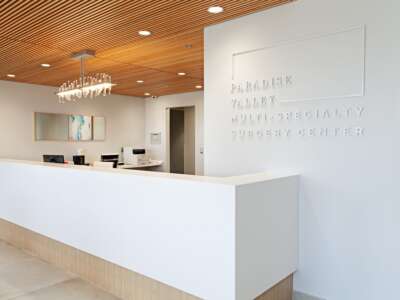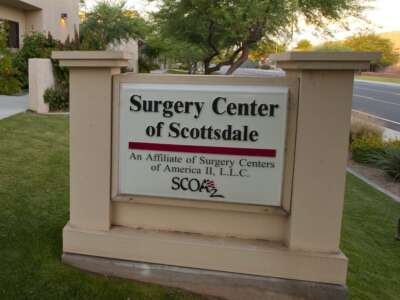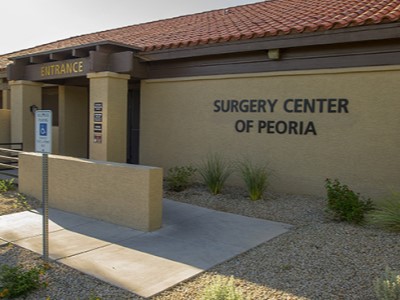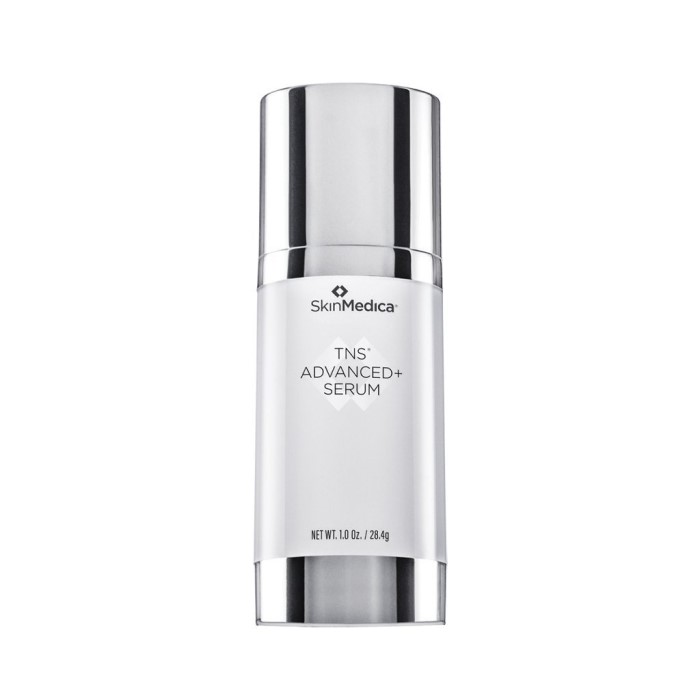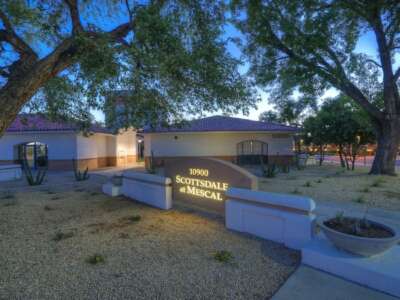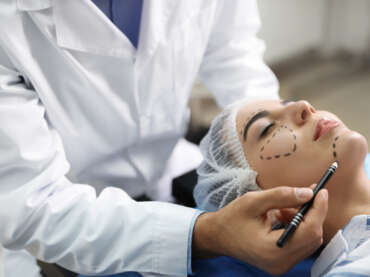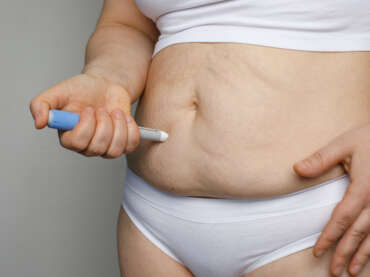Sam DeVictor, MD

“I believe in symmetry, balance, and aging beautifully; helping you achieve the health, wellness, and aesthetics unique to you.” – Dr. Samuel DeVictor
FACIAL PLASTIC SURGEON IN SCOTTSDALE, ARIZONA
MEET SAM DEVICTOR, MD
Dr. Samuel DeVictor’s journey into medicine stems from a deep-rooted desire to positively impact lives and society. He is driven by a passion for his patients and the tangible effects that facial plastic surgery can have on their health, confidence, and quality of life. Dr. DeVictor delights in precision, whether he’s engaged in surgery, painting, or woodworking. At DeVictor Facial Plastic Surgery, our commitment is to help you realize your aesthetic goals. We value symmetry, balance, and the art of aging gracefully, guiding you on your journey to wellness, beauty, and equilibrium.
COMMITMENT
FACIAL PLASTIC SURGERY
Dr. DeVictor understands that excellence in facial plastic surgery lies in the details. His meticulous approach and dedication ensure outstanding results for procedures ranging from rhinoplasty to complex facial reconstructions. Known for taking on challenging revision rhinoplasty cases, Dr. DeVictor stands out among facial plastic surgeons in Scottsdale, Arizona. His close rapport with patients and relentless pursuit of perfection have cemented his reputation as a leading surgeon in his field.
Setting him apart from other facial plastic surgeons in Arizona, he willingly takes on the challenge of complex revision rhinoplasty surgeries, and other facial and plastic procedures. Dr. DeVictor’s commitment to his craft, close rapport with his patients, and uncompromising pursuit of exceptional results have established him as one of the best Facial Plastic Surgeons in Scottsdale, Arizona.

SCHOOLING
EDUCATION & TRAINING
Dr. DeVictor’s academic excellence began with his selection for the President’s Emerging Global Scholars Program and his receipt of the Hope Scholarship, leading him to complete his Bachelor’s degree in Biology and Spanish at Emory University in just three years. He earned his medical degree from Mercer University School of Medicine, graduating with Distinction for Service to the Community.
His training in Otorhinolaryngology-Head and Neck Surgery at SUNY – Buffalo Jacobs School of Medicine under Dr. David Sherris, a premier rhinoplasty and cosmetic facial plastic surgeon, laid a strong foundation for his career.
Dr. DeVictor further honed his skills during his Facial Plastic and Reconstructive Surgery fellowship at UC Davis under Travis Tollefson, a world-renowned surgeon and editor of FPSAM journal. He also completed a fellowship in facial trauma with the International AO Foundation in craniomaxillofacial surgery.
Following his extensive training, Dr. DeVictor achieved Board Certification in both the American Academy of Otolaryngology-Head and Neck Surgery and the American Academy of Facial Plastic and Reconstructive Surgery, showcasing his dedication and expertise in the field.
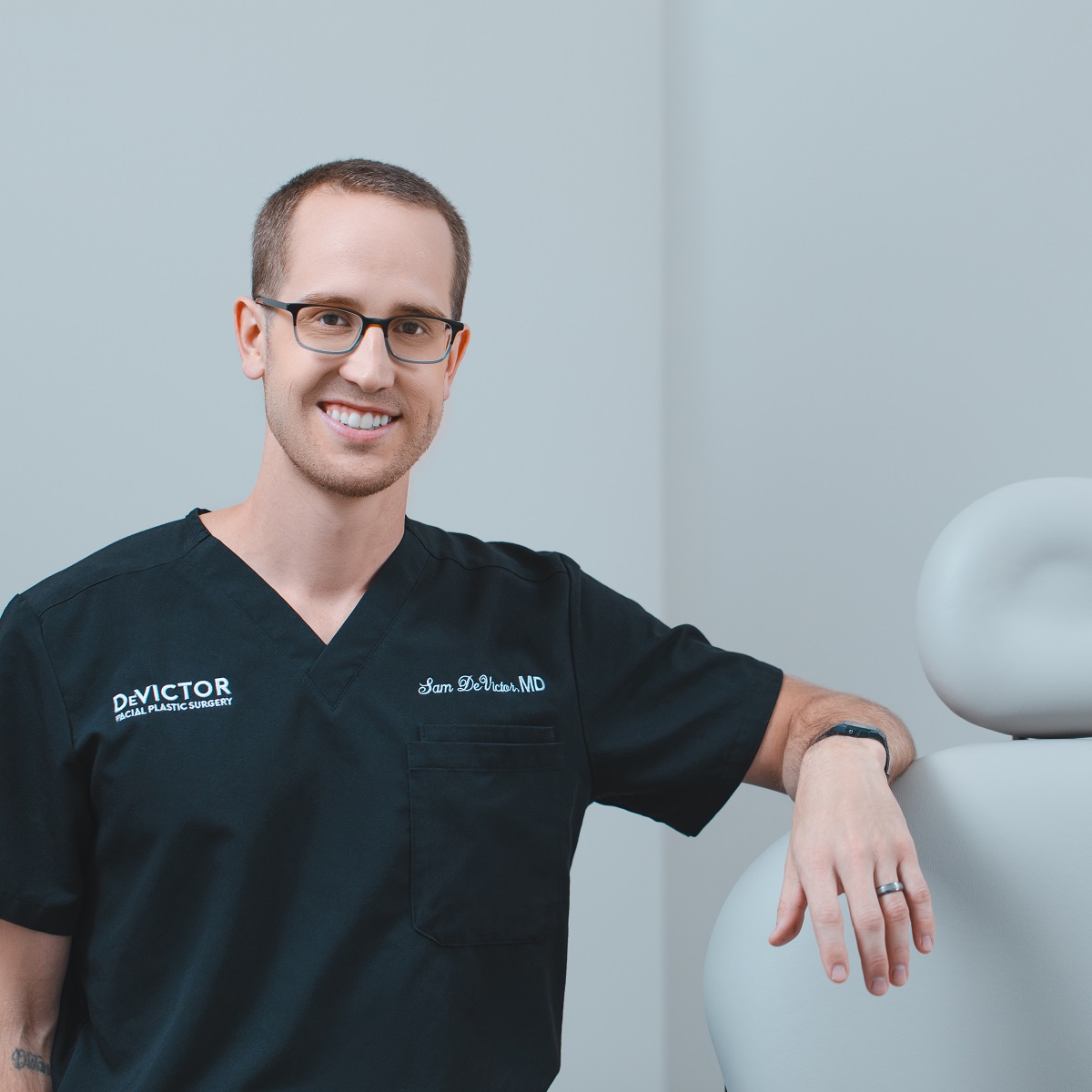
AFFILIATIONS
PROFESSIONAL MEMBERSHIPS
Dr. DeVictor is an active member of multiple medical associations and societies. He believes in a strong and unified network of physicians and medical providers in order to deliver the most transparent and up-to-date care.
- American Academy of Facial Plastic and Reconstructive Surgery
- AO Craniomaxillofacial Foundation
- American Academy of Otolaryngology-Head and Neck Surgery
- American Medical Association
- Arizona Medical Association*
FOCUS
SPECIALTIES & EXPERTISE
Dr. DeVictor’s unique background equips him to excel in cosmetic, functional, and revision rhinoplasty, as well as procedures aimed at fostering aging beautifully. His expertise extends to facial reconstruction and facial reanimation for patients dealing with skin cancer or facial paralysis, showcasing his wide-ranging skills and compassionate approach to patient care.
COMMUNITY
VOLUNTEERISM
For Dr. DeVictor, service is a calling. He frequently lends his medical expertise to international initiatives and underserved communities across America, with recent missions including work on cleft lip and palate defects in Guatemalan children. Driven by a vision of community upliftment, he is actively working towards establishing a non-profit organization to serve those in need in local communities.
PROCEDURES
ALL PROCEDURES OFFERED

Brow Lift
The shape and position of the eyebrows dramatically impact the way our face looks. As one ages, the position of our eyebrows can change as wrinkles, fine lines, and saggy or puffy skin impacts the shape of your face, changes your facial expressions, and leaves you feeling less confident. In many cases, a brow lift, which may also be referred to as a forehead lift, is a good option to restore a smooth, more youthful appearance. At Plastic & Reconstructive Surgery – a division of U.S. Dermatology Partners, our skilled team is happy to offer this surgical option. You can learn more about brow lift surgery on this page or by contacting Plastic & Reconstructive Surgery.
What Is a Brow Lift?
Brow lifts are typically recommended for people who are 35 years of age or older as the lowering of the brow line is often a result of aging. However, there are cases where people are genetically predisposed to have droopy skin around the eyes or a lower brow line, and they may benefit from this procedure at a younger age. A brow lift is a cosmetic procedure that improves the appearance of the face.
While the goal of the brow lift surgery is the same, there are three different versions:
- Open Brow Lift – This is an original version of the procedure and remains very popular and effective. It’s called an open brow lift because the skin is actually pulled back to reveal the tissues and muscle beneath, so they can be adjusted.
- Endoscopic Brow Lift – Rather than performing the brow lift procedure through an open incision, the endoscopic brow lift utilizes cameras inserted into a small opening to guide the adjustment of the muscles and tissues. This minimizes the risk of scarring and reduces healing time compared with the open brow lift.
- Forehead Shortening – For some, the brow looks low because the forehead is long, or the hairline is set too far back. In these situations, it may be beneficial to move the hairline down as well as lift the brow to create a shorter, more aesthetically pleasing forehead.
Benefits of Brow Lifts
If you want to smooth your skin, lift your eyes, and improve your overall appearance, a brow lift may be for you.
Some of the many benefits of this cosmetic surgery procedure include:
- Reducing the appearance of forehead and brow line wrinkles
- Renewing the eyebrow arch
- Elevating the brow line to its natural position
- Minimizing the appearance of wrinkles and fine lines around the eyes
- Eliminating excess skin
Recovery After Brow Lifts
Brow lift recovery will vary slightly based on the type of brow lift received. To minimize bruising and swelling, the forehead may be taped or bandaged around the surgical site. Additionally, a drain may be placed to remove fluids and blood around the incision sites that may accumulate under the skin. Once the original bandaging is placed, your surgeon will provide aftercare instructions that should be followed throughout healing. In 10-14 days, any stitches will be removed. After the first two weeks, you can return to work in most cases. After a month, you can resume more of your regular routine, including light exercise with your surgeon’s approval. Healing will continue for a few months after brow lift surgery.
Risks Associated with Brow Lifts
When performed by a qualified plastic surgeon, brow lifts are a relatively low-risk procedure, but all surgical procedures do come with associated risks.
Some of the common risks include:
- Bleeding
- Swelling
- Numbness
- Pain
- Asymmetry
- Need for revision surgery to achieve desired results
- Infection

Deep Plane Facelift
A facelift (rhytidectomy) is one of the most well-known facial rejuvenation procedures, and it is also one of the most popular cosmetic procedures in general. The deep plane facelift is an innovation of this popular procedure that delivers more natural-looking and longer-lasting facelift results through the repositioning of deeper face tissues. At Plastic & Reconstructive Surgery – a division of U.S. Dermatology Partners, our skilled cosmetic surgeons offer many of the latest procedures, including deep plane facelifts. You can learn more on this page or contact our cosmetic surgery team to schedule a consultation.
What Is a Deep Plane Facelift Procedure?
As part of the aging process, skin becomes lax and may appear loose, saggy, or crepey. Facelifts are designed to improve the appearance of skin tightness and smoothness to combat these effects of aging. The traditional facelift focuses on lifting just the skin to provide a taught facial appearance. This could leave skin looking and feeling inflexible and unnatural in some cases. There are advanced procedures referred to as SMAS facelifts that reposition the superficial musculature and skin. The results of this procedure were much more natural-looking, but they didn’t offer much longevity because the deeper musculature and soft tissue were still lax. The deep plane facelift procedure goes even deeper readjusting the ligaments and other attachments deep within the facial structure.
Benefits of Deep Plane Facelifts
Every cosmetic surgeon has a different approach and each person’s needs are different. However, there are many reasons why cosmetic surgeons may prefer this procedure and recommend you as a candidate for a deep plane facelift, including:
- Longitudinal studies and research are still ongoing but early indications suggest that the deep plane facelift procedure may deliver longer-lasting results compared with other forms of facelifts.
- More natural-looking results may be possible since deeper structures can be repositioned during the deep plane facelift. This reduces the risk of skin looking pulled or unnaturally taught since the deeper structures match the appearance of the smoothed skin tissues.
- A greater ability to remodel facial structures with more precision means the surgeon is able to achieve a more dramatic change. This includes repositioning fat stores in the cheeks for a generally more lifted appearance.
Recovery After the Deep Plane Facelift Procedure
Like any surgical procedure, deep plane facelifts do require recovery time. As you heal following treatment, you may notice skin tightening, numbness, bruising, and swelling. These side effects should begin to diminish within the first week after your deep plane facelift and continue to resolve over the next 2-3 weeks. Our team will walk you through the recovery process and make sure you have everything you need. If you have any concerns or questions throughout the process, please contact your surgeon to follow up.
Other Considerations
In many cases, a deep plane facelift works best when combined with other treatments. For instance, after a deep plane facelift, there may be some areas that are not directly addressed with this surgery. Specifically, laser resurfacing may be used to address skin flaws, pigmentation, and acne scarring. Injectables may be recommended for a fuller lip or to smooth and reshape deep folds. Additionally, facelifts may be recommended in conjunction with a neck lift to smooth and tighten the skin of the neck and throat. The best way to learn more about is to schedule a facelift consultation at Plastic and Reconstructive Surgery.
Risks Associated with Deep Plane Facelifts
While there are risks associated with any procedure, the deep place facelift has not been shown to have any increased risks compared to other types of facelifts. The risks of any procedure will vary from patient to patient based on history and post-procedure care. Additional questions and concerns can be discussed in greater detail at a consultation to help you to feel comfortable.

Earlobe Repair
The increased popularity of large, heavy earrings and gauges over the past several decades has significantly increased the need for earlobe repair. Some people who seek earlobe repair may wait assuming their earlobes will heal on their own. They can see minimal improvement after several years, but to see true restoration, a more advanced surgical treatment may be required. On this page, you can learn more about earlobe repair from the knowledgeable team at Plastic & Reconstructive Surgery – a division of U.S. Dermatology Partners. If you’re interested in this procedure, don’t hesitate to get in touch to schedule a consultation visit.
What Is Earlobe Repair?
Earlobe repair is a form of cosmetic surgery that is targeted at repairing damaged earlobes. Some of the reasons patients seek earlobe surgery include:
- Earlobe elongation or splits caused by wearing heavy earrings.
- Multiple, close-together piercings causing the earlobe to pull or distend.
- Large holes or gaps caused by gauges.
- Ripped or damaged earlobes caused by pulling on earrings or earrings snagging.
- Earlobe damage from burns, cuts, and other traumatic injuries.
Earlobe repair surgery should be performed by a skilled plastic surgeon. Preferably, a surgeon who specializes in facial cosmetic surgery should be chosen as they have experience working with small, sensitive, and complex facial structures. Depending on the patient’s specific goals and needs, earlobe repair surgery can be as simple as closing existing piercings. In more advanced cases, there may need to be tissue grafting, removal, or reshaping.
Benefits of Earlobe Repair
The main benefit of earlobe repair is to restore the ear to its appearance prior to being damaged. This improves confidence as many people feel that damaged earlobes are noticeable and draw unwanted attention. Sagging earlobes can also leave people looking older. Tightening the earlobes restores a more youthful appearance. Following earlobe repair, patients can re-pierce their ears. They should wait for three to six months or consult their surgeon before piercing ears following earlobe repair.
Recovery After Earlobe Repair
In most cases, earlobe repair is a same-day surgery that can be performed quickly under local anesthesia, so the patient is able to drive themself home after. Patients are typically able to return to work as soon as the day after treatment. There may be some mild pain for the first few days, but this is almost always manageable with over-the-counter pain relievers. Dressings or bandages are not typically required. Your surgeon will provide detailed instructions on caring for the area as well as recommend antibiotic ointments to be applied regularly. Any stitches should be removed after the first week or two.
Risks Associated with Earlobe Repair
The risks associated with earlobe repair surgery are relatively low when the procedure is performed by a qualified cosmetic surgeon. Most adverse effects of earlobe repair are typically very minor, but it’s still important to understand potential risks before beginning treatment. Infection is one of the main concerns associated with earlobe repair (and all plastic surgeries). For this reason, it’s important to follow your surgeon’s aftercare instructions closely. Additionally, there may be some scarring after the earlobe heals, but the surgeon will typically work to hide any scars on the back of the earlobe or in other less noticeable areas. If you notice excessive scarring or the formation of keloid scars, the procedure may require a revision.

Eyelid Reconstruction
Whether there is a lesion near your eye, or have a loss of function related to facial paralysis, eyelid reconstruction surgery may be the best solution to restore the natural appearance and function of the eyes. At Plastic & Reconstructive Surgery – a division of U.S. Dermatology Partners, we offer eyelid reconstructive surgery performed by plastic surgeons with years of experience. You can learn more about this surgical treatment on this page. When you’re ready to get started, don’t hesitate to contact our team to schedule a consultation.
What Is Eyelid Reconstruction?
Eyelid reconstruction may be recommended in a variety of situations, including removing moles and lesions, repairing Mohs surgery defects, restoring appearance after trauma, and addressing poor function related to facial paralysis including dryness, tearing, droopy eyelids, and loss of blink. Eyelid reconstruction can be used on the upper, lower, or both eyelids, depending on need.
Several different procedures may be performed as part of eyelid reconstruction, including:
- Tarsoconjunctival Flap – this involves pinning the upper and lower eyelids together for improved positioning and blinking
- Ectropion Repair – this involves repositioning a drooping lower eyelid.
- Tissue Transfer – this involves grafting skin, muscle, or cartilage from the donor site as part of the eyelid reconstruction process.
Benefits of Eyelid Reconstruction
Some of the many benefits of eyelid reconstruction include:
- Improving the appearance of the face and eyes
- Renewing eyelid function
- Restoring vision
Recovery After Eyelid Reconstruction
Immediately following surgery, your eyes will be swollen and bruised. Use cold compresses, keep your head elevated, and take pain relievers as directed during healing. It’s also important to moisturize the eyes as they can become dry. Lubricating eye drops and gels significantly improve dryness and irritation. Following upper eyelid reconstruction, patients can return to work after a few days. For lower eyelid surgery or combined eyelid reconstruction surgery, recovery takes a bit longer, and most patients will need to take at least two weeks off from work. Other activities can be reintroduced as tolerated after the first three weeks. Swelling and bruising will gradually subside over three to six weeks following surgery. The final results are typically revealed after two months following treatment.
Risks Associated with Eyelid Reconstruction
By working with a skilled professional cosmetic surgeon, you significantly reduce the risks associated with surgery. However, even the best cosmetic surgeons can’t prevent every surgical risk. Before you decide to proceed with surgery, discuss all potential risks with your surgeon and follow all aftercare instructions to minimize side effects.
Be aware that there are always risks when you move forward with surgery, including:
- Infection – the area around the eyes can be especially difficult to keep clean and sanitized during healing. This increases the risk of infection.
- Scarring – your surgeon will hide the incisions within the eye’s natural creases as much as possible, but there may still be some visible scar tissue after healing.
- Deeper Tissue Injury – nerves, muscles, blood vessels, and other structures can be damaged unintentionally during surgery.
- Numbness – loss of sensation around the surgical site that may be temporary or permanent.
- Vision Impairment – short or long-term loss of vision.

Eyelid Surgery
Droopy, puffy eyelids can make people look tired, older, and less healthy. Eyelid drooping may also lead to impaired vision. If you want to improve the appearance of your eyelids and increase eye health in general, eyelid surgery at Plastic & Reconstructive Surgery – a division of U.S. Dermatology Partners may be the right option for you. On this page, you can learn more about eyelid surgery, including the many benefits and what to expect from the healing and recovery process.
What Is Eyelid Surgery?
Eyelid surgery or blepharoplasty is a cosmetic surgery procedure that improves the appearance of sagging or puffy eyelids. This procedure can be performed for the upper eyelid, lower eyelid, or both. Upper and/or lower eyelid surgery can improve the appearance of sagging, skin laxity, fatty deposits, bags, puffiness, drooping eyelids, and excess skin. It may also be recommended to repair ptosis, a condition in which the upper eyelid droops and negatively impacts vision. The procedure is performed by making incisions along the eye’s natural creases. Then, the surgeon will remove the excess skin, muscles, and fat and reposition as necessary to achieve desired results. For best results, your plastic surgeon may recommend eyelid surgery be performed in conjunction with other cosmetic treatments. Specifically, a brow lift is often recommended along with the blepharoplasty procedure to improve the overall appearance of the eyebrow and eyelids.
Benefits of Eyelid Surgery
The main benefit of eyelid surgery is the cosmetic improvement, but there are many other reasons why blepharoplasty is such a popular treatment, including:
- Long-Lasting Results – The results of your eyelid surgery should last more than a decade.
- Improved Vision – Removing excess skin and lifting sagging eyelids can make vision clearer.
- Minimized Scarring – Because the incision is made in the eyelid crease, any scarring is hardly noticeable.
- Increased Confidence – When we look our best, we feel more confident and self-assured.
Recovery After Eyelid Surgery
Following surgery on the upper and lower eyelids, your surgeon will carefully apply ointment to aid in healing and prevent irritation and discomfort. Depending on the extent of the procedure, iced gauze may be applied over the eyes for the first few hours or days. Topical and oral medications will be provided by your surgeon to promote healing, prevent infection, and reduce discomfort. Follow all instructions provided by your surgeon and protect your eyes from sun exposure as they heal. Most people are able to return to their daily routine with some minor adjustments after the first two weeks. Exercise, heavy lifting, and general exertion should still be minimized until released by the surgeon. Initial healing will usually take a few weeks, but the surgical site will continue to improve for three to six months. Throughout healing, you will return to your surgery practice for follow-up visits to ensure you’re healing properly.
Risks Associated with Eyelid Surgery
Making the choice to receive cosmetic surgery should never be undertaken lightly. Even performed by a skilled surgeon, surgical procedures involve risk. Be sure to discuss potential risks and side effects with your surgeon before beginning the procedure.
Common risks associated with eyelid surgery include the following:
- Bleeding around the incision
- Bruising and swelling
- Pain or irritation
- Dry eye
- Lower eyelid rolling out (ectropion)
- Infection
- Sun sensitivity
- Scarring

Facelift for Facial Paralysis
Facelifts are some of the most widely known cosmetic surgery procedures, and they are often recommended to achieve a range of treatment goals. In addition to improving facial appearance, facelifts can also be utilized to restore more natural facial symmetry and natural resting position for those with facial paralysis by lifting sagging structures. On this page, you can learn more about facelift for facial paralysis. You can also contact our team at Plastic and Reconstructive Surgery, a Division of U.S. Dermatology Partners, to schedule a consultation. Our knowledgeable surgeons will be happy to discuss all of your treatment options for facial paralysis, including facelift.
What Is a Facelift?
A facelift is a cosmetic surgery procedure used to lift facial structures and improve appearance. However, it is also a popular solution for people who struggle with long-term facial paralysis and changes in facial symmetry caused by Bell’s palsy and other sources of facial paralysis. There are several different approaches to facelift that involve adjusting facial tissues and structures at different levels that range from pulling back just the outer layers of skin to adjusting deep musculature and structural tissues. Depending on the patient’s specific needs, the cosmetic surgeon will recommend the best option to deliver the desired results, restoring natural appearance and symmetry.
Benefits of Facelift for Facial Paralysis
The most important benefit of a facelift for facial paralysis is allowing the patient to reclaim their sense of self and experience greater confidence again. Additionally, facelifts help to counteract other negative effects of facial paralysis, including difficulty speaking, eating, and making facial expressions. Facelifts are also versatile, which means the individual’s facelift surgery plan can be customized to target exactly the areas that need to be addressed while minimizing the impact on areas of the face that are not negatively impacted by facial paralysis.
Recovery After Facelift for Facial Paralysis
Following a facelift, the cosmetic surgeon will place bandages and provide instructions for changing out coverings at home, or they will schedule a follow-up appointment to remove and replace the bandages and dressings. For the first week after treatment, you’ll likely notice bruising, swelling, and discomfort that can be managed with over-the-counter pain medications. Between ten days and two weeks after surgery, you can return to work. Make sure to get plenty of rest during this time to allow your body to heal. Your surgeon will let you know when it’s safe to resume other daily activities. When in doubt, pay attention to your body’s response, and forego any activities that cause bleeding, swelling, or pain.
Risks Associated with Facelift for Facial Paralysis
Surgical procedures all have complications, we have the necessary training and experience to mitigate the vast majority of surgical risks. Even with the added complexity of addressing facial paralysis, an experienced facial plastic surgeon can safely provide facelift procedures.
While our trusted surgeons will work to provide the safest treatment, there is still a possibility that patients can experience adverse effects like:
- Infection
- Scarring
- Excessive bleeding
- Worsening swelling and pain
- Skin numbness around the surgical site

Facial Paralysis Reanimation Treatment
There are a variety of reasons a patient may experience facial paralysis. While facial paralysis can impact speech, chewing ability, self-confidence, and overall health and well-being, there are effective treatment options available, including surgical and non-surgical reanimation procedures. You can keep reading to learn more about reanimation for facial paralysis. If you’re interested in scheduling a consultation with a skilled plastic surgeon, don’t hesitate to reach out to the knowledgeable team at Plastic & Reconstructive Surgery – a division of U.S. Dermatology Partners.
What Is Facial Paralysis Reanimation?
Surgical and non-surgical reanimation treatments are designed to improve appearance, function, and dynamic facial expressions following facial paralysis.
Surgical reanimation may be recommended following facial paralysis that occurs because of:
- Bell’s Palsy
- Congenital facial paralysis
- Facial trauma
- Brain tumor
- Nerve damage
- Ramsey hunt syndrome – facial paralysis related to shingles
Before recommending a surgical or non-surgical reanimation treatment for facial paralysis, your surgeon will work with you to determine your hopes and goals in possible treatments.
Some of the top recommended non-surgical reanimation solutions for facial paralysis include:
- Botox – may be recommended to address nerve damage related to Bell’s palsy or unwanted movements, synkinesis, that may happen as a result of Bell’s palsy.
- Dermal Fillers – may be used to restore lost facial volume related to facial paralysis.
- Physical Therapy – in many cases, performing exercises under the direction of a physical therapist can help restore function and improve appearance.
If deemed necessary to achieve the desired improvement, you may want to schedule a consultation to explore surgical reanimation options, including:
- Selective Myectomy – often recommended to address concerns following Bell’s palsy, including synkinesis, or involuntary movement. This procedure divides the muscles to restore balance and symmetry to muscle movements.
- Selective Neurolysis – this is recommended for those with facial paralysis accompanied by synkinesis. It can help to prevent misfiring nerves that cause unwanted muscle movements.
- Static Suspension – also called a static sling, this surgical treatment involves using a skin tissue called fascia lata taken from the thigh to lift the mouth and cheek when they are drooping.
- Temporalis Tendon Transfer – this surgical procedure involves making an incision in the skin’s natural crease between the lip and cheek as well as an incision inside the mouth to attach the bone and tendon beneath to the corner of the mouth, pulling it up into a more natural and symmetrical position. This procedure is unique in that it allows for dynamic movement and restoration of a smile.
- Blepharoplasty – eyelid surgery used to reconstruct the upper and/or lower eyelids. These treatments may tighten skin, repair muscles, and remove unwanted fatty deposits.
- Platinum Eyelid Weights – this surgical treatment implants small platinum weights into one or both eyelids to restore the ability of the eyes to fully close following facial paralysis. This prevents eye dryness, inflammation, and possible blindness in the long term.
- Brow Lift – if facial paralysis leads to a drooping brow, a brow lift procedure may be recommended to reverse the effects. This surgical procedure is completed by making incisions in the skin to pull back the tendons and muscles below and reposition the brow.
- Facelift – like a brow lift, facelifts involve making strategic incisions and pulling back facial musculature and tendons to create a tight, smooth appearance.
- Cranial Nerve Transfer – this advanced surgical procedure involves grafting a non-functional nerve to one that is working properly to restore proper function. The nerve is typically taken from another part of the body and affixed to the non-functional nerve.
Benefits of Facial Paralysis Treatment
The main benefit is clear – the restoration of facial expression and movement.
Other benefits include:
- More confidence
- Greater range of facial motion
- Increased comfort during facial movement
- Address ancillary concerns like drooping skin
- Improved speech clarity
Recovery After Facial Reanimation
Your recovery plan will vary depending on the specific procedure you receive. A consultation with our surgeons to discuss proper care after the procedure and to promote healing will be important. You should schedule follow-up visits with us to ensure you make a full recovery.
Risks Associated with Facial Paralysis Reanimation
Risks associated with facial reanimation surgery for paralysis are similar to risks associated with other surgical procedures. Immediately following treatment, you may experience swelling, bruising, bleeding, scarring, infection, and general discomfort as the surgical sites heal. Because of the variety of procedures offered for facial paralysis, there will be a more in-depth discussion at the time of your consultation.

Facial Reconstruction Surgery
Reconstruction surgery may be recommended to improve the appearance after the results of injury, damage, surgery, trauma, or congenital defects. There are a wide range of reconstructive surgeries. To learn more about your options, you can explore the details on this page or schedule a consultation at Plastic & Reconstructive Surgery – a division of U.S. Dermatology Partners.
What Is Reconstruction Surgery?
While reconstructive surgery may be performed on any part of the body, it is most commonly performed to restore damaged facial structures. The goal of reconstructive surgery is to restore lost or damaged structures for a more natural, flawless appearance.
Some of the most common forms of reconstructive surgery offered at the Plastic & Reconstructive Surgery include:
- Mohs Defect Reconstruction – following Mohs surgery to remove skin cancer, some people have indentations and deep scarring. Numerous reconstructive options can be used to improve the appearance including skin grafting, skin flap treatment, or cartilage grafts.
- Cleft Lip Revision – for those born with a cleft lip, surgery may be recommended to improve the appearance. This may include closing the cleft, scar revision of the lip, and improving the shape of the upper lip. Rhinoplasty (nose job) may also be recommended.
- Otoplasty – this procedure uses permanent sutures (stitches) to adjust the position of protruding ears. It may also involve changing the shape or size of the ear.
- Earlobe Repair – if the earlobe has become elongated, split, or misshapen, earlobe repair may be recommended. A variety of surgical techniques may be utilized to adjust and reshape the earlobe.
Benefits of Reconstruction Surgery
The main reason people choose to receive reconstruction surgery is that they want to restore their natural appearance, so they can look and feel more like themselves.
There are many additional benefits to receiving reconstructive plastic surgery, including:
- Improved self-esteem and self-worth
- More aesthetically pleasing appearance for increased confidence
- Increased function and range of motion
- Relief from pain
Recovery After Reconstruction Surgery
Following your reconstruction surgery, your plastic surgeon will walk through aftercare instructions to ensure you heal quickly. They should also schedule periodic follow-up visits to check your healing progress. Regardless of your specific recovery plan, it’s essential to get plenty of rest as you heal. The surgical site should also remain elevated as much as possible to minimize swelling, inflammation, and discomfort. You should also eat a nutrient-rich diet and drink plenty of water. Depending on the complexity of your procedure, you will likely need to refrain from exercise for several weeks. Your surgeon can give you a specific time frame. If you notice any concerns, consult with your surgeon right away.
Risks Associated with Reconstruction Surgery
Deciding to receive surgery will always come with associated risks, but a qualified plastic surgeon can perform surgeries in such a way that risks are minimized. Risks commonly associated with surgery include bleeding, bruising, scarring, infection, and swelling following the procedure.

Fat Grafting
If you’ve heard of dermal fillers, you’re familiar with the general idea of fat grafting. Fat is injected beneath the skin to achieve cosmetic or reconstructive goals after being harvested from areas where fat is unwanted or unneeded. On this page, you can learn more about what fat grafting is, how it works, and what to expect from the procedure. If you’re ready to get started, reach out to the knowledgeable team of professionals at Plastic & Reconstructive Surgery – a division of U.S. Dermatology Partners to schedule a consultation visit.
What Is Fat Grafting?
For those who are looking for a minimally invasive way to significantly improve their facial appearance, fat grafting may offer an ideal solution. Unlike other kinds of fillers made from synthetic solutions, fat grafting uses the patient’s own fat stores to achieve the desired results, making it a safer option in many cases. The process is completed in two parts. The first is liposuction, which removes fat stores from an area where there is excess, typically the thigh or hip. Once the fat is removed through liposuction, it is processed and injected into the face where the fat can be shaped beneath the skin to plump up wrinkles, fine lines, and concave scars. Fat grafting may also be used to redefine or reshape certain facial features.
Benefits of Fat Grafting
Fat grafting is a safe and versatile procedure. It uses biocompatible materials harvested from the patient’s body. This means people are less likely to experience adverse reactions following fat grafting, making it one of the safest ways to achieve a smooth, full, plump, youthful appearance. Fat grafting may be recommended to smooth out skin that has lost fullness due to aging, or fat can be injected to reshape facial features. In addition to improving the patient’s appearance, fat grafting can also be used to plump up concave areas of skin that have been damaged and scarred.
Recovery After Fat Grafting
There are only mild side effects during healing from a fat grafting procedure. In most cases, patients return to their regular activities the day after their procedure. After the first few days, swelling, bruising, and other common symptoms of this treatment should be reduced or completely resolved. Once the desired results are achieved, patients typically maintain these results for life. However, it’s important to remember that the natural fatty tissues injected under the skin are still subject to being lost if the patient loses weight. For this reason, it’s often recommended to wait until the patient is at or near their goal weight before pursuing fat grafting. Gaining weight may also impact the results of facial fat grafting as can changes in facial shape related to aging.
Risks Associated with Fat Grafting
One of the many benefits of fat grafting for facial rejuvenation is the safety of this procedure. The few side effects and risks related to this treatment are very mild. The majority of patients will simply experience minor bruising, swelling, and discomfort. Others may experience more advanced symptoms like severe bruising (hematoma) and changes in sensation near the treatment site.
Some patients develop more serious side effects following fat grafting, including:
- Bacterial infection
- Fatty cell necrosis
- Blood clots
- Fat embolism
- Deformity
More severe side effects are rare, especially when fat grafting procedures are performed by an experienced and qualified cosmetic surgeon.

Lip Lift Surgery
Many people are unhappy with the appearance of their lips. Whether they feel their lips are too small, not plump enough, or the shape is irregular, there are numerous surgical and non-surgical cosmetic procedures used to improve the appearance of the lips and mouth. You have likely heard of treatments like lip injections, dermal fillers, and even lip flips. All of these minimally invasive procedures offer improvement in the appearance of the mouth in different ways. Fillers and injections plump up the lips by filling them with natural or synthetic materials. Lip flips give the mouth a fuller appearance by causing the top lip to curl upward. While these treatments offer some improvement in the appearance of lips, they are all temporary. Over time, you will need retreatment to retain results. Lip lift surgery can deliver similar improvements in the appearance of lips, but the results are permanent. Keep reading to learn more about this minimally invasive, innovative procedure from Plastic & Reconstructive Surgery – a division of U.S. Dermatology Partners.
What Is a Lip Lift Procedure?
Surgical lip lifts are performed as an in-office procedure. Lip lifts can be performed under local anesthesia, but plastic surgeons often combine numbing medication with IV sedation or general anesthesia to ensure complete comfort. The surgery itself involves removing a small amount of skin between the nose and upper lip. This causes the lip to appear fuller. It reveals more of the teeth when smiling, and the lip lift adds height to the red lip. There are several variations in the lip lift procedure, including:
- Subnasal Bullhorn – This is the most common form of lip lift procedure, and it’s performed by removing skin directly beneath the nose in a bullhorn shape.
- Direct Lip Lift – Removes a small amount of skin immediately above the mouth and pulls the lip upward, revealing more of the pink part of the lip.
- Corner Lift – Also referred to as a smile lift or grin lift, this procedure is performed by making incisions at the corners of the mouth to give the lips an upturned appearance.
Benefits of Lip Lift Treatment
There are many benefits you can expect following a lip lift, including:
- Fuller lip appearance
- More youthful look
- More attractive smile
- Feel more confident about your smile
- Enjoy permanent results
Recovery After Lip Lift Surgery
It’s important to rest for at least 24 hours after your lip lift surgery. Your surgeon will provide you with specific instructions, but you should be sure to keep the area clean, avoid rubbing or irritating skin, and make sure to protect the healing surgical site from the sun. You should also keep your skin moisturized as it heals. Your surgeon can recommend a good product to protect the skin without causing irritation. Additionally, you should avoid exercise and other strenuous activities, stop smoking, and brush your teeth very carefully.
Risks Associated with Lip Lifts
The most common risk associated with lip lift surgery is scarring. Most surgeons will make an effort to minimize the appearance of surgical scars by placing incisions along existing creases in the skin. Infection is always a risk when receiving surgical procedures, but with proper aftercare, the risk for infection is minimal.

Mini Neck Lift
The skin on the neck and jawline is thin, and it is often the first part of the body that starts to show our age. For this reason, neck lifts are some of the most popular facial plastic and reconstructive surgery procedures available. If you want to improve the appearance of “turkey neck,” or sagging and wrinkled skin on the neck, a mini neck lift may be the ideal treatment option. On this page, you can learn more about the mini neck lift procedure. The cosmetic surgery team at Plastic & Reconstructive Surgery – a division of U.S. Dermatology Partners can also help you better understand mini neck lifts and all of your treatment options.
What Is a Mini Neck Lift Procedure?
A mini neck lift is a plastic surgery procedure designed to improve the appearance of the neck and jawline, including smoothing laxity and wrinkles and removing unwanted fullness. This minimally invasive surgical technique allows for maximum results with less scarring and shorter recovery times. A traditional neck lift may require multiple incisions, but a mini neck lift is typically completed with a less invasive approach. This means the procedure itself is completed more quickly. It also allows the patient to heal more quickly and reduces the risk of scarring. The surgical procedure is performed under local anesthesia that numbs the surgical site. The patient may opt to receive additional sedation or anesthesia to ensure comfort. During mini neck lift surgery, incisions are made, and the skin and some muscles may be pulled taught, excess skin may be removed, or tissues may be repositioned to achieve the desired results.
Benefits of Mini Neck Lifts
The main benefit of a mini neck lift is improving the appearance and definition of the neck, chin, and jaw.
Additional benefits include:
- Removing turkey neck and excess or saggy skin
- Eliminating double chin and excess fat in the chin and jaw
- Tightening and smoothing the neck
- Significantly shorter recovery times compared with traditional and deep neck lifts
- Less risk for scarring and other potential side effects of neck lifts
Recovery After the Mini Neck Lift Procedure
Following a mini neck lift procedure, your board-certified plastic surgeon will provide aftercare instructions to ensure fast and comfortable healing. For the first day or two, you will need to keep your head bandaged, rest, and take over-the-counter pain relievers to manage pain. Within the first few days, swelling and bruising are common, but they should begin to improve after a week. Full healing will continue for several months, but patients can typically return to their regular routines within a few weeks to a month following the procedure. The results will last about five years, but these results can be prolonged with a good skincare routine. This should include retinol to tighten the skin, improve cell turnover, and promote the production of collagen and elastin.
Risks Associated with Mini Neck Lift
The risks associated with mini neck lifts are similar to other minimally invasive surgeries. Your cosmetic surgeon will review potential risks with you as well as discuss any lifestyle or medical factors that increase the risk for adverse effects. In most cases, bruising, swelling, and bleeding below the skin are the only side effects patients deal with. Scarring is another common concern, but the procedure is designed to hide the incision sites and scars.

Mini Facelift
As we grow older, signs of aging begin to become more apparent. Facelifts are often considered the go-to cosmetic rejuvenation procedure to reverse the signs of aging and restore the appearance of smooth and youthful skin. While a full facelift offers a dramatic improvement for many people, others are looking for something a little less extensive. For those patients, a mini facelift may be a better option. At Plastic & Reconstructive Surgery – a division of U.S. Dermatology Partners, we work alongside our cosmetic surgery patients to find the right facelift option and cosmetic treatments to achieve their goals.
What Is a Mini Facelift Procedure?
A mini facelift procedure is designed to effectively lift the skin on the bottom portion of the face to remove and smooth sagging skin around the neck and jaw. Unlike a traditional facelift, there are fewer incisions, and almost all of them are hidden by the hairline. This delivers facial rejuvenation with a less invasive cosmetic procedure that can heal more quickly. A mini facelift is an ideal option for people who notice mild to moderate loose, sagging, or crepey skin around the jaw, cheeks, and neck.
Benefits of Mini Facelifts
There are numerous benefits of a mini facelift, including:
- Fewer incision sites. This minimizes the risk of scarring and infection.
- May be performed under local anesthesia rather than general anesthesia. This means the procedure can be performed more quickly with a shorter recovery period.
- Because the procedure is less extensive than a traditional facelift, it can help patients achieve similar results at a lower cost.
Recovery After the Mini Facelift Procedure
Mini facelifts are designed to be less invasive. This means the recovery process isn’t as extensive as traditional facelifts. There will still be some swelling, bruising, and discomfort as your body heals following treatment, but in most cases, people start looking and feeling better within a week after their mini facelift procedure. The appearance will continue to improve for the next several weeks. As your skin heals following your mini facelift, be sure to follow your plastic surgeon’s care instructions closely. You’ll likely need to keep the surgical sites covered for several days. You may also have stitches or drains that need to be removed during a prescheduled follow-up appointment.
Risks Associated with Mini Facelifts
The main benefit of mini facelifts is that there are fewer incisions, which minimizes the risk of adverse side effects. Even so, this is still a surgical procedure that can have complications. Any side effects are typically very mild and will vary from patient to patient based on history and post-procedure care. Additional questions and concerns can be discussed in greater detail at a consultation to help you to feel comfortable.

Mohs Defect Reconstruction
Mohs surgery is one of the leading skin cancer treatment options. This innovative surgical technique allows surgeons to remove cancer cells while minimizing the impact on surrounding, healthy tissue. Even though this procedure is conservative compared to traditional surgical excisions, there will still be a loss of healthy tissues. Mohs surgery may leave marks, indentations, scars, and deep pits in the skin that are unsightly, especially when skin cancer is removed from the face. In these cases, Mohs defect reconstruction surgery may be recommended to restore the lost tissue and improve appearance. On this page, you can learn more about what Mohs defect reconstruction is and what to expect from this procedure. If you want more information or you’re interested in getting started with this surgical treatment, Plastic & Reconstructive Surgery – a division of U.S. Dermatology Partners is here to help. Don’t hesitate to reach out to ask any questions you may have or schedule a consultation with one of our knowledgeable surgeons.
What Is Mohs Defect Reconstruction?
Mohs micrographic surgery is typically performed by a dermatologist as part of skin cancer treatment. The surgery involves removing thin layers of the cancer lesion and small amounts of surrounding tissue. As each layer is removed, it’s carefully examined under a microscope. The process is repeated until there are no cancer cells present in the layer of removed tissue. Compared to traditional surgical skin cancer removal, this process does help to retain healthy tissue, but defects may still be present. In this situation, a patient can work with a plastic surgeon to help close the wound or hole that is left after the Mohs procedure. Many patients opt to have Mohs defect reconstruction performed immediately after their skin cancer removal with the dermatologist, while other Mohs defects may benefit from closure with a facial plastic surgeon. Most commonly, the Mohs repair with facial plastic surgery would be performed 1-2 days after the Mohs procedure. Consult with your Mohs micrographic surgery provider to determine the best course of action for your particular case.
Depending on the results of the Mohs surgery, a variety of reconstructive surgical techniques may be utilized. Considerations before reconstruction planning include the size and location of the surgical defect and scar visibility. In some cases, a skin graft, using tissue from another location, is performed to replace the lost structure. In other situations, a skin flap, which uses adjacent tissue to cover the defect, may be recommended. For those whose Mohs surgery defect goes deeper, a cartilage graft may also be needed to fully restore structure. Other procedures may be recommended depending on the patient’s specific needs.
Benefits of Mohs Defect Reconstruction
The main benefit of Mohs defect reconstruction is clear – the restoration of a patient’s appearance following surgery. For those patients whose skin cancer is removed from the face, Mohs defect reconstruction may be especially beneficial. Repairing Mohs defects can also improve confidence and help patients move forward following skin cancer treatment.
Recovery After Mohs Defect Reconstruction
Immediately following your Mohs defect reconstruction surgery, you may notice some swelling and pain. This is a normal part of the healing process. For the first week, change bandages and dressings regularly and keep the area clean as instructed by the surgeon. For most people, over-the-counter pain medications are adequate to manage discomfort, but prescription pain medications may be prescribed as needed. Within a week, any stitches will be removed, and swelling and discomfort typically begin to diminish as well. Most people can return to work around this time, and they can gradually add more activity as tolerated over the next two to three weeks.
Every person heals differently, so the amount of time it takes to recover will vary. After your procedure, your surgeon should provide a healing and aftercare plan to guide you through the process. Following all instructions is essential to ensure you make a full recovery with minimal discomfort.
Risks Associated with Mohs Defect Reconstruction
Any surgery comes with some risks, but Mohs defect reconstruction surgery, when performed by a qualified professional, has significantly low risk.
While Mohs defect reconstruction is considered a safe procedure, some risks and concerns patients should be aware of before getting started include:
- Poor wound healing – skin grafts and other repairs can be rejected by the body, or the site may not heal well in general.
- Infection – look for skin that is warm to the touch around the surgical site, fever, nausea, chills, and other common signs of infection.
- Excessive bleeding – if the surgical site continues to bleed after the first few days, contact your surgeon.
- Numbness – loss of sensation in the treatment area is common during healing and can be permanent.

Otoplasty
The ears are often overlooked when it comes to cosmetic surgery, but there are many reasons why a patient might choose to move forward with otoplasty (the clinical term for plastic surgery of the ears). Otoplasty may be recommended to improve the appearance, shape, and symmetry of the ears. You can learn more about this procedure below or by contacting Plastic & Reconstructive Surgery – a division of U.S. Dermatology Partners to schedule a consultation visit. During your consultation, a knowledgeable cosmetic surgeon will answer your questions and review treatment options to ensure otoplasty is the best option.
What Is Otoplasty?
Otoplasty refers to any type of ear surgery. This term may be referring specifically to plastic and cosmetic surgery, but it is also a general term used for any kind of ear surgery. Otoplasty procedures may be used to change the size, shape, protrusion, or symmetry of the ears. Otoplasty may also be recommended to correct birth defects, scar tissue, damaged earlobes, and other congenital defects or irregularities caused by injury. This cosmetic surgery procedure also corrects or improves the results of previous surgeries. The goal of otoplasty is to create a more aesthetically pleasing appearance while balancing facial proportions.
There are many reasons why patients choose to move forward with otoplasty, including:
- Improving facial symmetry
- Repairing the appearance of earlobes damaged by earrings and gauges, burns, and other injuries
- Removing excessive growth of keloid scar tissue
- Correcting genetic malformations
- Reducing ear protrusion
Benefits of Otoplasty
Like other types of cosmetic and reconstructive surgery, otoplasty can improve the patient’s sense of confidence and self-esteem. Unlike other types of plastic surgery that are only recommended for adults, otoplasty may be recommended for adolescents and even younger children to improve the appearance of genetic malformations.
Recovery After Otoplasty
After otoplasty, there will likely be mild pain and discomfort. Over-the-counter pain relievers are adequate to manage pain for most people, but your surgeon may recommend prescription pain medications if they believe it’s necessary. Your surgeon will place bandages and instruct you on when to remove them. Make sure to follow these directions closely as removing the bandages too soon can lead to poor healing and other concerns, including increased chances for revision surgery. Once the bandages are removed, your surgeon will provide care instructions to ensure the surgical sites heal quickly and comfortably.
Risks Associated with Otoplasty
Any surgical procedure will have associated risks, but when you work with a skilled facial plastic surgeon, you can be assured that they will do their utmost to provide safe, well-planned treatment that mitigates risk. While your surgeon will do everything possible to ensure you achieve the desired results with little to no negative side effects, some adverse responses can occur following surgery.
Some of the common risks associated with otoplasty include:
- Allergic response to surgical materials, dressings, or medications
- Adverse response to anesthesia
- Excessive bleeding
- Loss of sensation or change in sensation
- Pain that lasts after healing
- A wound that doesn’t heal properly
- Scarring
- Infections

Platinum Eyelid Weights
Many of us take blinking our eyes or closing them when we go to sleep at night for granted but imagine if you lost the ability fully close one or both eyes. For many people who have facial paralysis, loss of eyelid function is a real concern. Platinum eyelid weights can restore full eye closure. Learn more about this surgical treatment option on this page, or get started with a consultation by contacting the knowledgeable professionals at Plastic & Reconstructive Surgery – a division of U.S. Dermatology Partners.
What Are Platinum Eyelid Weights?
Platinum eyelid weights are a unique surgical solution for patients who struggle to blink or fully close their eyes due to facial paralysis. This leaves the eyes exposed to potential irritation or injury, and it causes eye dryness and even blindness. Thin platinum eyelid weights allow the eye to fully close. There are numerous sizes and shapes available, so they can be comfortably placed to achieve the desired results without causing a noticeable change in the appearance of the eyelids. The procedure is performed by making a small incision in one of the eyelid’s natural creases to hide the future scar. Then, the small weight is inserted. The entire platinum eyelid weight placement procedure is relatively quick and entirely reversible. If the patient regains eyelid function, the weight can be removed in a short visit.
Benefits of Platinum Eyelid Weights
There are many benefits of choosing platinum eyelid weights to ensure eye function, including:
- Allowing for complete passive and intentional eyelid closure
- Protecting the eye from damage and irritation
- Improving the ability to blink
- Increasing eye moisture
- Biocompatible platinum is safe even for those who have sensitivity to metals
- The ultra-small weight won’t interfere with metal detectors or MRIs
Recovery After Platinum Eyelid Weight Placement
Immediately following treatment, patients will experience swelling, bruising, and discoloration. These symptoms may increase for the first few days before starting to improve. Most symptoms resolve within two weeks, but it may take several months for the symptoms to resolve entirely. Be conscious of the fact that when you’re sleeping, your eyes may swell up, but that overnight swelling should subside through the day.
The surgeon will provide specific instructions to follow during healing, but most patients should:
- Apply ice packs as long as tolerated for the first three days. Then, apply an ice pack for twenty minutes at a time a few times a day for the next week.
- For the first week, sleep propped up or seated in a recliner to reduce pressure on the eyelids.
- The day after treatment, you can shower and wash your face. Be gentle around the incision.
- Apply antibiotic ointments and take oral antibiotics as directed by your surgeon.
- Take pain relievers to manage discomfort.
- Avoid strenuous activities and exercise for the first two weeks.
- Do not use cosmetics for the first few weeks following surgery.
Risks Associated with Platinum Eyelid Weight Placement
Like other surgical procedures, platinum eyelid weight placement has risks. Your surgeon will take steps to reduce any risks before, during, and after the procedure.
However, if you notice any of the following warning signs, contact your facial plastic surgeon as soon as possible as they are warning signs of more serious concerns:
- Fever
- Vomiting or nausea
- Pain that increases instead of subsiding
- Numbness or tingling

SELECTIVE MYECTOMY
For those who struggle with synkinesis (unwanted muscle contractions) or facial muscle spasms, finding a solution to restore their natural facial appearance and movements can be a real struggle. Many of the most invasive surgical options are only minimally effective. Selective myectomy offers improved facial balance and control to manage synkinesis and some unwanted or involuntary facial muscle movements. On this page, you can learn more about selective myectomy, how it works, the benefits, and what to expect following treatment. The knowledgeable professionals at Plastic & Reconstructive Surgery – a division of U.S. Dermatology Partners are also here to help if you have questions. Simply reach out to schedule a consultation with one of our knowledgeable professionals.
What Is Selective Myectomy?
The surgical term myectomy refers to the act of severing muscles. Selective myectomy involves cutting facial muscles to alleviate pressure that causes muscle tightness or involuntary facial movements. Depending on the individual’s presentation with synkinesis, a muscle may be severed on the healthy side, the side experiencing muscle tension, or both. The goal is to alleviate unnecessary strain that leads to facial asymmetry by releasing tensed muscles. In addition to improving the appearance of facial asymmetry caused by synkinesis, selective myectomy may also be performed to reduce or eliminate symptoms like spastic or overly tight muscles in the face that are causing undesired movements or facial expressions, opening and closing the eyes, or making speaking or turning the head more difficult or uncomfortable. Selective myectomy is often performed in conjunction with selective neurectomy. This procedure involves severing nerves that are misfiring, leading to irregular movements.
Benefits of Selective Myectomy
The most obvious benefit of selective myectomy is the relief from facial tightness-related synkinesis and muscle spasms.
Additional benefits include:
- Alleviating muscle tightness
- Relieving pain in the neck and jaw related to muscle tightness
- Giving facial expressions a more balanced appearance
- Creating a symmetrical appearance
- Reducing damage from biting the cheeks or tongue due to muscle tightness
Recovery After Selective Myectomy
Following treatment, most patients can return home the same day. Patients usually need a trusted loved one to drive them home and monitor them for the first day. Selective myectomy patients may notice some swelling in the lips and discomfort that lasts for several days. The surgeon provides specific aftercare instructions, but recovery care usually involves taking antibiotics and using a cleansing and antimicrobial oral rinse to prevent infection during healing. The aftercare diet should be soft foods that are unlikely to irritate the incisions or open stitches. Because the incisions are usually made inside the mouth, there is minimal risk of scarring.
Risks Associated with Selective Myectomy
Most risks associated with selective myectomy are the same that can be expected following any surgical procedure. Infection, excessive bleeding, and damage to deeper tissues and structures are all possible. However, these risks are uncommon, especially for patients who follow the aftercare instructions. Additionally, some people may lose feeling in their lower lip, but this more serious side effect is almost always temporary with normal sensation restored after a few months. Others feel bumps or knots within their surgical incisions. These lumps are usually scar tissue that forms during the healing process. Massaging and stretching the knotted area can reduce the size or eliminate them entirely.

Selective Neurolysis
For those who struggle with Bell’s palsy and synkinesis, there are few procedures available that adequately address the side effects. Selective neurolysis, also known as selective neurectomy, is often a beneficial solution to address unwanted facial movements and restore natural-looking expression and function. It works by severing nerves that lead to involuntarily moving muscles while preserving neuropathways that link to the muscles necessary to speak, chew, smile, and otherwise function from day to day. On this page, you can learn more about selective neurolysis. If you’re ready to discuss your options with a trusted professional, we hope you’ll get in touch with the team at Plastic & Reconstructive Surgery – a division of U.S. Dermatology Partners to explore your options.
What Is Selective Neurolysis?
Synkinesis is a common side effect for Bell’s palsy patients who have symptoms that don’t clear up on their own. Synkinesis occurs when multiple nerves are activated simultaneously, causing unwanted and uncontrolled facial movements. This can lead to difficulty smiling and making other facial expressions. Synkinesis also impacts facial symmetry and function. Selective neurolysis is one way to improve the effects of synkinesis. This treatment works by severing nerves that cause unwanted muscle contraction. Facial nerves branch out attaching to muscles. Before performing selective neurolysis, the surgeon carefully maps out the branches to ensure appropriate treatment. By severing certain branches, selective neurolysis prevents unwanted facial movements. For some, this procedure may be combined with selective myectomy, a severing of facial muscles. This is especially true for those who are experiencing extreme muscle tightness or spasms in addition to unwanted facial movements.
Benefits of Selective Neurolysis
Restoring a more natural smile and overall facial function and symmetry are the top benefits of selective neurolysis, but there are many other advantages to pursuing this treatment option, including:
- Results are noticeable within just a few days of treatments
- Relatively short recovery time compared to similar treatments
- Alleviate tightness in the facial muscles
- Improved muscle control and coordination
- Improved smile appearance, symmetry, and function
- Long-lasting results
Recovery After Selective Neurolysis
Compared with similar treatments, the recovery following selective neurolysis is relatively minimal. Depending on the individual’s response to selective neurolysis, the patient may need to stay in the hospital overnight, but most can return home on the same day as their treatment. Your plastic surgeon will provide aftercare instructions to help you heal quickly and minimize any risks associated with the procedure. Within the first few days, patients should begin to see a noticeable improvement in facial expressions. For several months, healing and facial control should continue to improve. Some patients benefit from working with a physical therapist following treatment to further increase facial control.
Risks Associated with Selective Neurolysis
The knowledgeable professionals at Plastic & Reconstructive Surgery have years of experience and advanced training that ensure patients receive the best and safest possible care. They will work with you to minimize risk and ensure you heal quickly and maintain the results of selective neurolysis.
Common risks associated with selective neurolysis include:
- Damage to surrounding nerves, blood vessels, or muscles
- Treatment may be ineffective if the surgeon proceeds with too much caution and doesn’t address enough of the overactive nerves
- Increased loss of facial movement or control
- Weakened facial muscles
- Scarring
- Infection

Static Sling
When facial paralysis occurs, one side of the face may droop or sag. The other side will appear higher and tighter, making the paralysis more noticeable. Static sling or static suspension is a surgical procedure performed to lift the sagging side of the face. There are many benefits to this procedure, but static sling can be extremely complex. It’s essential that you work with skilled professionals who have experience and advanced training in facial plastic surgery like the knowledgeable cosmetic surgeons at Plastic & Reconstructive Surgery – a division of U.S. Dermatology Partners. On this page, you can learn more about what a static sling is, how the procedure is performed, and what to expect following surgery. When you’re ready to get started, don’t hesitate to reach out to our team to schedule a consultation visit.
What Is Static Sling?
Static sling is a surgical procedure that uses fascia lata from the thigh to lift sagging that occurs due to facial paralysis. Because of the extent of this surgery, static sling is only recommended for long-lasting facial paralysis symptoms that aren’t responsive to more conservative treatments. The static sling surgical procedure involves sewing the fascia lata beneath the skin starting at the corner of the mouth. The fascia lata is then used to lift the face before being attached at the temple. It keeps the corner of the mouth lifted even while at rest to improve facial symmetry. Static sling may be recommended on its own to address facial paralysis, or it can be combined with other treatments like facelifts or Botox.
Benefits of Static Sling
There are many benefits of static sling. The most important is the restoration of confidence and self-esteem experienced by those who have been struggling with the adverse effects of facial paralysis on their appearance. Additionally, static sling can allow those with facial paralysis to speak more clearly, chew more effectively, smile, and generally have more natural-looking facial movements. For others, facial paralysis makes it difficult or impossible to completely close their eyes. Static sling can restore the ability to blink and keep eyes closed, which alleviates symptoms like dry, watery, or itchy eyes.
Recovery After Static Sling
Static sling surgery is an invasive procedure, so it’s important to talk through all potential risks and the recovery process with your cosmetic surgeon before moving forward with this treatment option. After static sling treatment, the patient will need to care for surgical sites on both the face and the thigh. Swelling and pain are the two most common symptoms impacting the surgical sites.
Rest is extremely important to ensure healing. Patients can stand and walk after this procedure, but activity should be minimized for the first two to three weeks following surgery to allow the face and leg to heal. The use of compression wraps on the leg can help to alleviate pain and swelling. The facial incision may be wrapped in bandages, or it may have a drain for a short period to remove fluid that collects under the skin. This drain will need to be removed by your surgeon during a follow-up visit. Most symptoms subside within the first few weeks after treatment.
Risks Associated with Static Sling
Your plastic surgeon will walk you through all of the risks and considerations associated with surgery before beginning treatment. It’s important to understand that a static sling doesn’t improve facial movement. Instead, it’s designed to restore facial symmetry, which can lead to some improvement in certain facial movements. One of the main concerns related to static sling is that this procedure is not permanent. Over time, the fascia lata will stretch out, leading to drooping, but this typically doesn’t happen for several years following treatment. Risks associated with static sling include excessive bleeding, adverse response to anesthesia, infection, and scarring. Most risks can be avoided by working with a qualified facial plastic surgeon and getting in touch with your surgeon at the first sign of concern.

Temporalis Tendon Transfer
The temporalis tendon plays an essential role in our daily life. It allows people to speak, chew, smile, and generally live a comfortable daily life. For those who have nerve damage or facial paralysis, temporalis tendon transfer can restore a more natural resting facial appearance and improve facial expression and movement. On this page, you can learn more about this effective procedure to improve facial function. If you’re interested in learning more, schedule a consultation with the trusted team at Plastic & Reconstructive Surgery – a division of U.S. Dermatology Partners. Their skilled cosmetic surgeons can walk you through your treatment options and help you find the best option to meet your needs.
What Is Temporalis Tendon Surgery?
The temporalis muscle runs from the mouth, across the cheek, and up to the temple. It is a key factor in numerous facial movements from smiling to speaking and chewing. When people have facial paralysis, nerve damage, or other impediments in the fluid movement of this muscle, it may be beneficial to undergo temporalis tendon surgery. This procedure involves cutting a hole in the temporalis muscle and attaching it to the temporalis tendon at the corner of the lip. This lifts a drooping mouth to restore facial symmetry. In many cases, temporalis tendon transfer is combined with other procedures or physical therapy to ensure the best possible results.
Benefits of Temporalis Tendon Surgery
The main benefit of temporalis tendon transfer is restoration of appearance and improved function for those who struggle with long-term facial paralysis. Additional benefits include improving speech, alleviating discomfort related to facial paralysis, and allowing for more natural-looking facial expressions.
Recovery After Temporalis Tendon Transfer
Temporalis tendon transfer is an advanced surgical procedure performed under general anesthesia, and it may require a stay at the hospital. Once released, you’ll follow the care instructions outlined by your surgeon. You’ll need to eat soft foods for a few weeks after treatment. Avoid touching or placing pressure on the side of the face where surgery was performed. You should also sleep propped up to allow circulation and avoid blood pooling, which can increase inflammation. Your surgeon will provide recommendations for when you can return to work and other daily activities based on your specific procedure and the way your body responds.
Risks Associated with Temporalis Tendon Surgery
Temporalis tendon transfer is an advanced surgical procedure, which means there are numerous potential risks. The important thing to remember is that your plastic surgeon has years of training and experience performing these procedures, and they will take every precaution before, during, and after treatment to ensure you make a full recovery. However, it’s always wise to go into surgery with a complete understanding of potential risks.
Some common risks associated with temporalis tendon transfer surgery include:
- Anesthesia Complications – adverse reactions to general anesthesia may occur, requiring emergency intervention.
- Allergic Response – adverse reactions to medical dressings, stitches, medications, or other aspects of the medical procedure.
- Infection – the surgical site may become infected, leading to swelling, skin feeling warm to the touch, and fever.
- Scarring – surgeons will do their best to disguise scarring within the natural lines of the face, but some scarring may still occur.
- Damage – deeper tissues like nerves and muscles may be inadvertently damaged during the procedure.
- Numbness – this loss of sensation may be temporary or permanent.
SPOTLIGHT PROCEDURE
Rhinoplasty
The shape and size of the nose can transform the facial profile. Some nose shapes are considered more desirable than others, and if you’re one of the many people who are unhappy with the appearance of your nose, rhinoplasty may be a good option. Our knowledgeable cosmetic surgeons can help you explore options for changing the shape, size, or position of your nose, so you look and feel your best.
NEXT STEPS
What to Expect at Your Consultation
Choosing DeVictor Facial Plastic Surgery means choosing a partner in your journey towards balance, beauty, and wellness. Dr. DeVictor and our team are eager to discuss your aesthetic aspirations, answer your questions, and outline potential surgical options. We coordinate closely with you to schedule procedures at times that suit your life, ensuring a seamless and supportive experience.
These revisions aim to enhance the clarity, flow, and engagement of the content while subtly integrating variations of the target keyword where relevant. Make sure to continually monitor the performance of your content and remain open to further optimizations as needed.

Partner Locations
Surgery Centers
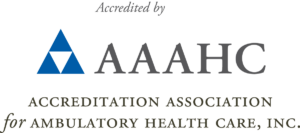
HOW TO
SURGERY PROCESS
Consult
Schedule
Pre-Op
Post-Op
If you have any questions or concerns throughout the process, we will be here to serve you through your surgical experience.
FAQS
SURGERY CENTER Q & A
FEATURED PRODUCT
TNS ADVANCED+ SERUM
Key Benefits
• Smooths visible coarse wrinkles and fine lines
• Clinically proven to address sagging skin
• Results starting in just 2 weeks
• Progressive results measured over 24 weeks
Location
Center for Aesthetic and Laser Medicine Scottsdale
CONTACT US
(480) 865-2717
Fax: (833) 738-3622
HOURS
MONDAY 8:00AM-5:00PM
TUESDAY 8:00AM-5:00PM
WEDNESDAY 8:00AM-5:00PM
THURSDAY 8:00AM-5:00PM
FRIDAY 8:00AM-5:00PM














